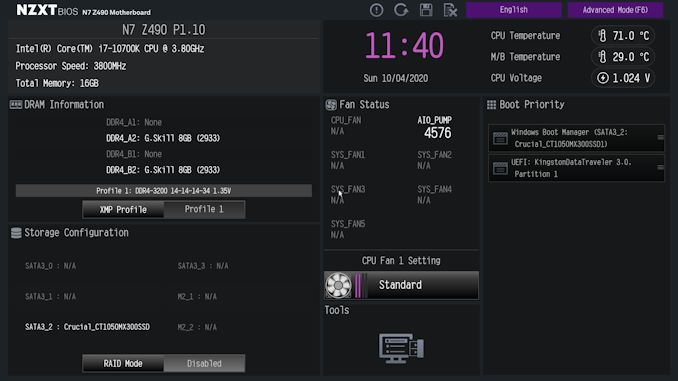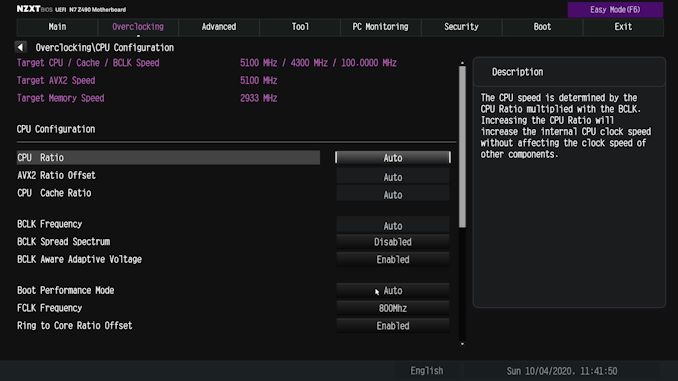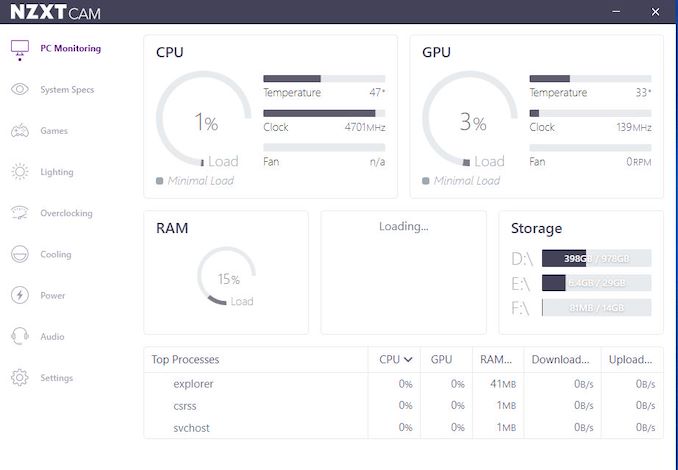The NZXT N7 Z490 Motherboard Review: From A Different Direction
by Gavin Bonshor on October 7, 2020 10:30 AM EST- Posted in
- Motherboards
- Intel
- ASRock
- NZXT
- Z490
- Comet Lake
- Intel 10th Gen
- i7-10700K
- N7 Z490
BIOS
Although the N7 Z490 is NZXT's latest motherboard on the market, the ASRock OEM does the heavy lifting regarding the firmware, with all the hallmarks of an ASRock BIOS, with a custom NZXT GUI. The interface includes a black background with grey and white text, with some vibrant purple accentuation.
The NZXT/ASRock UEFI firmware includes two primary modes, basic and advanced. Looking at the basic mode, it includes a basic list of information on the installed hardware, with some function through the X.M.P 2.0 profile enabler, which can be done at the click of a button. Users can alter the CPU fan setting in the basic mode, and enable or disable RAID mode, and set a boot priority, and that's about it. It does include basic monitoring for the board 4-pin fans.
A simple press of the F6 key will alternate between the basic and advanced modes, with the latter featuring the more comprehensive list of options for users to customize. All of the boards overclocking functions can be found within the Overclocking menu, with all three core menus including CPU, DRAM, and voltage, each getting its own section. Within the CPU area, users can adjust the CPU and BCLK frequencies to overclock the CPU, with options for AVX2 ratio offset adjustment and CPU Cache ratio control. Users can tweak memory settings in the DRAM section, with plenty of options for altering memory latencies, although users can enable X.M.P 2.0 profiles on compatible memory within three clicks.
Outside of the typical overclocking and monitoring functions, there isn't much in the way of features with NZXT's firmware with a basic fan profile customizer. NZXT keeps things simple with the GUI, functionality. However, all of the relevant settings for customizing Intel's Thermal Velocity Boost are present, so all of the tools needed to squeeze more performance out of Intel's Comet Lake processors is available to use. The firmware itself is strong and stable, with more than enough for users to sink their teeth into, without over complicating things where it doesn't need to be.
Software
The NZXT software bundle comes amalgamated via its CAM software, which acts as the central hub for all the available utilities. It offers various menus covering different elements of the software, including a cool PC Monitoring section, an overclocking section for users to perform basic VGA overclocking, and a lighting section for users looking to customize externally added RGB LEDs.
The CAM software is one of NZXT's most prominent software packages in the companies history and is used across most of its devices. Relating directly to the N7 Z490, the NZXT CAM software allows plenty of functionality, including power options, when used with compatible NZXT power supplies, enabling the boards' customization 4-pin cooling headers, as well as an integrated section for the onboard audio.
It should be noted that the version of the NZXT CAM software we were sent from NZXT for the N7 Z490 review is currently still in BETA, and as such, doesn't seem completely polished off. Despite having the drivers for the Realtek ALC1220 HD audio codec installed, the audio section wasn't functional. The overclocking section includes a large warning screen that provides a caution for users looking to make adjustments. This is especially useful for regular users without much experience who go browsing and tweaking settings without much thought for consequences that overclocking without knowledge can have. Unfortunately, the CAM software at present doesn't allow for CPU or memory overclocking within Windows, with the only VGA currently supported within CAM.
The games section provides a list of playtime for each game played used, which can be useful for monitoring how much time is actually spent gaming, especially when users should be working. Alas, it could be useful for me, who spends a lot of the evening gaming, perhaps too much!

























45 Comments
View All Comments
Slash3 - Wednesday, October 7, 2020 - link
...The Aristocrats!SaolDan - Wednesday, October 7, 2020 - link
Love it!EWP - Wednesday, October 7, 2020 - link
I love it! Perfect response to the "must-have feature" whiners that long for the days when all "real" computers needed to be build is "super tower" cases to make room for their one HDD, one CD-ROM, and maybe three expansion cards (video, sound, and modem) along with 4+ more empty slots that they never filled.I do have one complaint though. I was expecting an integrated micro nuclear reactor instead of a PSU...they are so last millennia. As if. Primitives.
jabber - Thursday, October 8, 2020 - link
Yeah I don't know why those folks just don't buy a big server/workstation and leave the rest of us to get on with stuff.Cooe - Wednesday, October 7, 2020 - link
Stay off amphetamines kids.m00bee - Wednesday, October 7, 2020 - link
lol, where is like buttonprophet001 - Wednesday, October 7, 2020 - link
Eh... this thing is a hotbox.Makes sense though seeing as how their cases are hotboxes too.
Flunk - Wednesday, October 7, 2020 - link
Looks good, ASRock is a decent OEM... shame about the Intel. I'm buying a new high-end board soon but it's going to be AM4.Arbie - Wednesday, October 7, 2020 - link
So they aim at a niche market (Intel CPUs) and fail at the one remaining (alleged) attraction of those chips: manual overclocking.Gigaplex - Wednesday, October 7, 2020 - link
Intel CPUs still tend to get the highest performance in games. That may change soon with Zen 3.I do like how we're even considering calling Intel "niche" these days though.